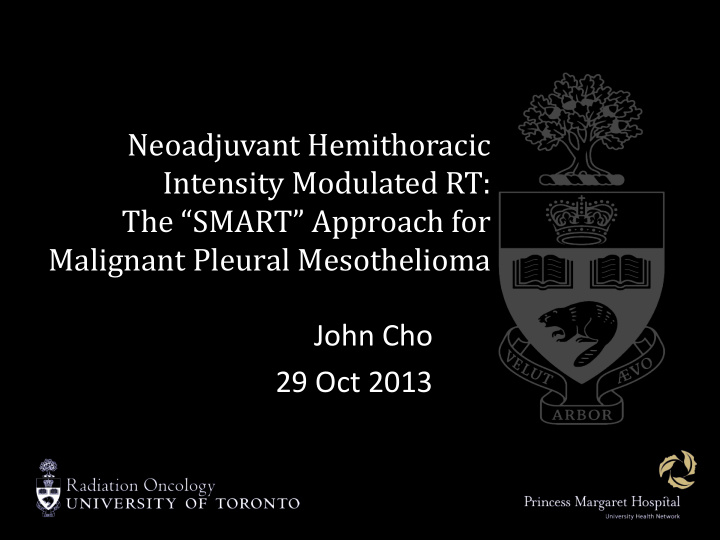



Neoadjuvant Hemithoracic Intensity Modulated RT: The “SMART” Approach for Malignant Pleural Mesothelioma John Cho 29 Oct 2013
Disclosures • None
Overview • Asbestos • Mesothelioma • Evolution of Therapy • SMART
Asbestos • asbestos use dates back to 4500 years ago – Finnish pottery • fabled fur of mythical salamander
Asbestos Chrysotile (white) Amosite (brown) Crocidolite (blue)
Resection • early attempts at radical resection (pleurectomy/decortication, extrapleural pneumonectomy) universally disappointing – up to 30% perioperative mortality rate – up to 80% local recurrence rate
Rusch. J Thorac Cardiovasc Surg 2001
Overall Survival median 14 mos
Survival by Nodal Status and Therapy
Recurrences after Trimodality Therapy • Recurrences 16/30 patients Ipsilateral chest: 4 Pericardium: 1 Peritoneum: 5 Contralateral chest: 4 Chest and peritoneum: 2
Recurrences after Trimodality Therapy • Recurrences 16/30 patients Ipsilateral chest: 4 local Pericardium: 1 Peritoneum: 5 distant mets Contralateral chest: 4 Chest and peritoneum: 2
Rationale for Neoadjuvant Therapy • to down stage tumour to improve resectability – R+ R0 • to reduce local failure – sterilize “high risk” margins • to reduce distant failure?
Neoadjuvant Hemithoracic RT • large, complex volumes • optimal fractionation and scheduling unknown – 45 Gy/25 fx x 5 w then EPP at 4 weeks? – risk of radiation pneumonitis?
S urgery for M esothelioma A fter RT Study Schema Malignant Pleural Mesothelioma (cT1-2 cN0 M0) Baseline Investigations Informed Consent Neoadjuvant Hemithoracic Intensity Modulated Radiotherapy (25 Gy/5 fx over 1 week) 1week post-RT Extrapleural Pneumonectomy 6-12 weeks post-op pN0-1 pN2 Observation Adjuvant Chemotherapy
Results • accrual completed 10/2012 • 25 patients (19 males, 63±8 years old, 21 right sided tumors) • all patients completed IMRT and EPP • IMRT well tolerated with no grade 3-5 toxicity – limited to nausea, fatigue
Results • EPP performed 6±2 days after completion of IMRT • no deaths within 30 days of surgery or in- hospital • at least 1 complication occurred in 18 patients during follow-up after surgery
Table. Complications occurring after induction IMRT and EPP Grade 0 Grade 1 Grade 2 Grade 3 Grade 4 Grade 5 Thromboembolic event 22 0 1 1 1 0 Atrial fibrillation 15 0 5 5 0 0 Wound infections 22 0 2 1 0 0 Chylothorax 23 0 0 2 0 0 Hemothorax 24 0 0 0 1 0 Wound dehiscence 21 1 2 1 0 0 Renal dysfunction 24 0 0 1 0 0 Pneumonia 24 0 0 0 1 0 Empyema 23 0 0 1 0 1 Bronchopleural fistula 25 0 0 0 0 0
Overall survival 100 90 80 Survival (%) 70 62% 60 50 40 30 20 10 0 0 12 24 36 48 60 months after radiation Survival by histology 100 epithelial 82% 90 (16) biphasic 80 Survival (%) 70 60 p =0.004 50 40 30 19% 20 (9) 10 0 0 12 24 36 48 60 Months after radiation
Results • median survival: 13 months • median FU: 18 months • overall 3-year survival: 62% • significantly better OS for epithelial compared to biphasic MPM subtype (p=0.004) – OS at 3 yrs, 83% for epithelial (16) and 19% for biphasics (9)
Survival by nodal status 100 ypN0-N1 90 87% (10) ypN2 80 Survival (%) 70 60 50 40% (15) 40 30 20 10 0 0 12 24 36 48 60 Months after radiation
Results • 10 patients developed recurrence – ipsilateral chest only (n=2) – ipsilateral chest and distant sites (n=2) – distant sites only (n=6)
What we’ve learned • short neoadjuvant hemithoracic RT followed by EPP for resectable MPM is feasible and safe – requires high degree of cooperation and coordination between surgical and radiotherapy teams – high rates of patient compliance
What we’ve learned • radiotherapy continue to evolve and adapt as we optimize technique – well tolerated extending target volume to thoracic outlet and diaphragmatic attachments – include high risk areas such as chest tube sites, retroperitoneal nodes avoid geographical misses
Acknowledgements • Marc de Perrot • Ron Feld • Natasha Leighl • Lea Dungao • Pat Merante
Thank you for your attention
Recommend
More recommend